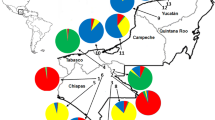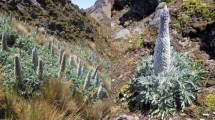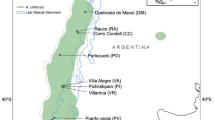Abstract.
The geographic distribution of allozyme variation within the Eurasian boreo-nemoreal woodland grass Melica nutans L. has been investigated together with a minor subset of other Melica species. Twenty alleles were found at nine polymorphic loci in M. nutans. Allelic richness was highest in areas central in the species' European distribution, i.e. in southern Fennoscandia. High population densities, reducing the effects of genetic drift, as well as accumulation of variation through long-distance gene-flow from different marginal populations, is proposed to explain high allelic richness in this area. Several alleles showed geographic patterns in distribution and frequency variation. However, these patterns were not congruent, e.g. some alleles appear to have migrated to northern Europe from the south-west whereas others may have spread from the east. Genetic distances between geographic regions, each consisting of 2–6 populations, were generally low between all Fennoscandian, Russian and Siberian regions, but much higher between western and continental European regions. On the population level, cluster analysis grouped populations from Siberia, Russia, coastal and lowland areas in Fennoscandia and British Cumbria into one subcluster whereas other subclusters contained mainly south-west European populations or populations from almost throughout the distribution range. A scenario with several independent glacial refugia in central Europe, south-western Siberia and possibly western Norway, and subsequent colonisation of Fennoscandia mainly from the east, but with some long-distance gene-flow from central Europe, is proposed.
Similar content being viewed by others
Author information
Authors and Affiliations
Additional information
Received April 3, 2002; accepted September 17, 2002 Published online: December 11, 2002
Rights and permissions
About this article
Cite this article
Tyler>, T. Large-scale geographic patterns of genetic variation in Melica nutans, a widespread Eurasian woodland grass. Plant Syst. Evol. 236, 73–87 (2002). https://doi.org/10.1007/s00606-002-0235-8
Issue Date:
DOI: https://doi.org/10.1007/s00606-002-0235-8




